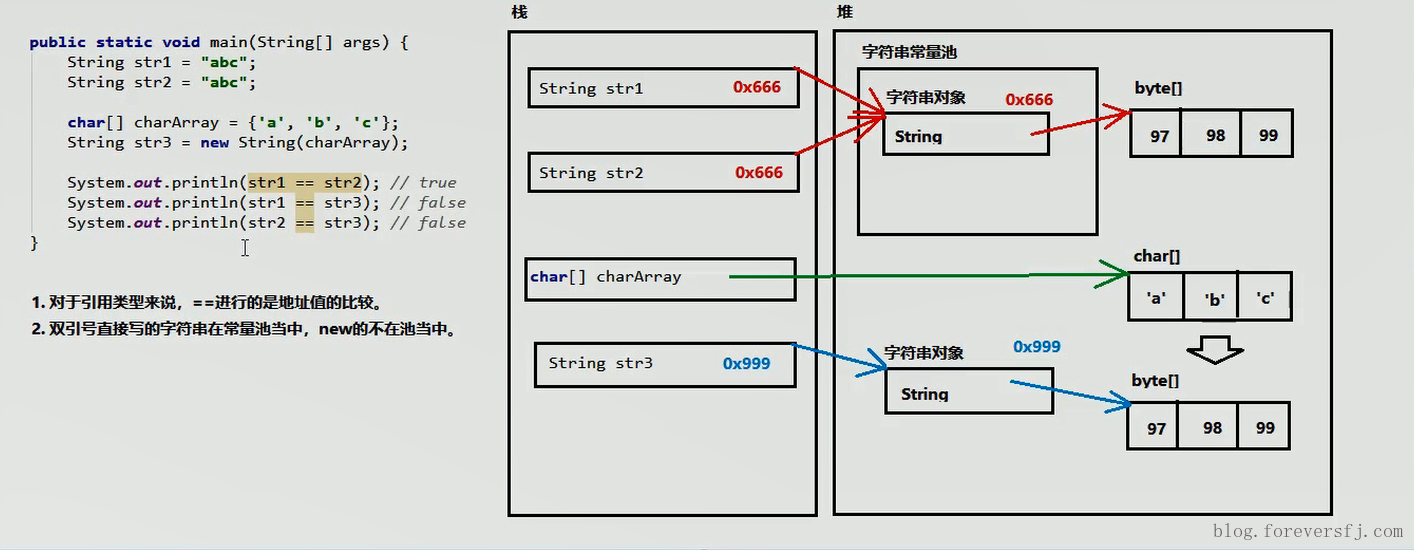第二部分 第十章 4.String类
条评论10.4 String类
10.4.1 String类概述
概述
java.lang.String类代表字符串。Java程序中所有的字符串文字(例如"abc")都可以被看作是实现此类的实例。
类String中包括用于检查各个字符串的方法,比如用于比较字符串,搜索字符串,提取子字符串以及创建具有翻译为大写或小写的所有字符的字符串的副本。
特点
字符串不变:字符串的值在创建后不能被更改。
1
2
3
4String s1 = "abc";
s1 += "d";
System.out.println(s1); // "abcd"
// 内存中有"abc","abcd"两个对象,s1从指向"abc",改变指向,指向了"abcd"。因为String对象是不可变的,所以它们可以被共享。
1
2
3String s1 = "abc";
String s2 = "abc";
// 内存中只有一个"abc"对象被创建,同时被s1和s2共享。字符串常量池。“abc” 等效于 char[] data={ ‘a’ , ‘b’ , ‘c’ } 。
1
2
3
4
5
6例如:
String str = "abc";
相当于:
char data[] = {'a', 'b', 'c'};
String str = new String(data);
// String底层是靠字符数组实现的。
10.4.2 使用步骤
查看类
java.lang.String:此类不需要导入。
查看构造方法
public String():初始化新创建的 String对象,以使其表示空字符序列。public String(char[] value):通过当前参数中的字符数组来构造新的String。public String(byte[] bytes):通过使用平台的默认字符集解码当前参数中的字节数组来构造新的String。
构造举例,代码如下:
1 | // 无参构造 |
10.4.3 常用方法
字符串常量池
字符串常量池:程序当中直接写上的双引号字符串,就在字符串常量池中。
对于基本类型来说,== 是进行 数值 的比较。
对于引用类型来说,== 是进行 地址值 的比较。

判断功能的方法
public boolean equals (Object anObject):将此字符串与指定对象进行比较。- 任何对象都能用Object进行接收。
equals方法具有对称性,也就是a.equals(b)和b.equals(a)效果一样。- 如果比较双方一个常量一个变量,推荐把常量字符串写在前面。
- 推荐:
"abc".equals(str)不推荐:str.equals("abc")
public boolean equalsIgnoreCase (String anotherString):将此字符串与指定对象进行比较,忽略大小写。方法演示,代码如下:
1
2
3
4
5
6
7
8
9
10
11
12
13
14
15
16
17
18
19
20
21
22
23
24
25
26
27
28
29
30
31
32public class String_Demo01 {
public static void main(String[] args) {
String str1 = "Hello";
String str2 = "Hello";
char[] charArray = {'H', 'e', 'l', 'l', 'o'};
String str3 = new String(charArray);
System.out.println(str1.equals(str2)); // true
System.out.println(str2.equals(str3)); // true
System.out.println(str3.equals("Hello")); // true
System.out.println("Hello".equals(str1)); // true
String str4 = "hello";
System.out.println(str1.equals(str4)); // false
System.out.println("=================");
String str5 = null;
System.out.println("abc".equals(str5)); // 推荐:false
// System.out.println(str5.equals("abc")); // 不推荐:报错,空指针异常NullPointerException
System.out.println("=================");
String strA = "Java";
String strB = "java";
System.out.println(strA.equals(strB)); // false,严格区分大小写
System.out.println(strA.equalsIgnoreCase(strB)); // true,忽略大小写
// 注意,只有英文字母区分大小写,其他都不区分大小写
System.out.println("abc一123".equalsIgnoreCase("abc壹123")); // false
}
}Object 是” 对象”的意思,也是一种引用类型。作为参数类型,表示任意对象都可以传递到方法中。
获取功能的方法
public int length ():返回此字符串的长度。public String concat (String str):将指定的字符串连接到该字符串的末尾。public char charAt (int index):返回指定索引处的 char值。public int indexOf (String str):返回指定子字符串第一次出现在该字符串内的索引。public String substring (int beginIndex):返回一个子字符串,从beginIndex开始截取字符串到字符串结尾。public String substring (int beginIndex, int endIndex):返回一个子字符串,从beginIndex到endIndex截取字符串。含beginIndex,不含endIndex。方法演示,代码如下:
1
2
3
4
5
6
7
8
9
10
11
12
13
14
15
16
17
18
19
20
21
22
23
24
25
26
27
28
29
30
31
32
33
34public class String_Demo02 {
public static void main(String[] args) {
//创建字符串对象
String s = "helloworld";
// int length():获取字符串的长度,其实也就是字符个数
System.out.println(s.length());
System.out.println("===========================");
// String concat (String str):将将指定的字符串连接到该字符串的末尾.
String s = "helloworld";
String s2 = s.concat("**hello itheima");
System.out.println(s2);// helloworld**hello itheima
// char charAt(int index):获取指定索引处的字符
System.out.println(s.charAt(0));
System.out.println(s.charAt(1));
System.out.println("===========================");
// int indexOf(String str):获取str在字符串对象中第一次出现的索引,没有返回‐1
System.out.println(s.indexOf("l"));
System.out.println(s.indexOf("owo"));
System.out.println(s.indexOf("ak"));
System.out.println("===========================");
// String substring(int start):从start开始截取字符串到字符串结尾
System.out.println(s.substring(0));
System.out.println(s.substring(5));
System.out.println("============================");
// String substring(int start,int end):从start到end截取字符串。含start,不含end。
System.out.println(s.substring(0, s.length()));
System.out.println(s.substring(3,8));
}
}
转换功能的方法
public char[] toCharArray ():将此字符串转换为新的字符数组。public byte[] getBytes ():使用平台的默认字符集将该 String编码转换为新的字节数组。public String replace (CharSequence target, CharSequence replacement):将与target匹配的字符串使用replacement字符串替换。方法演示,代码如下:
1
2
3
4
5
6
7
8
9
10
11
12
13
14
15
16
17
18
19
20
21
22
23public class String_Demo03 {
public static void main(String[] args) {
//创建字符串对象
String s = "abcde";
// char[] toCharArray():把字符串转换为字符数组
char[] chs = s.toCharArray();
for(int x = 0; x < chs.length; x++) {
System.out.println(chs[x]);
}
System.out.println("‐‐‐‐‐‐‐‐‐‐‐");
// byte[] getBytes ():把字符串转换为字节数组
byte[] bytes = s.getBytes();
for(int x = 0; x < bytes.length; x++) {
System.out.println(bytes[x]);
}
System.out.println("‐‐‐‐‐‐‐‐‐‐‐");
// 替换字母it为大写IT
String str = "itcast itheima";
String replace = str.replace("it", "IT");
System.out.println(replace); // ITcast ITheima
System.out.println("‐‐‐‐‐‐‐‐‐‐‐");
}
}CharSequence 是一个接口,也是一种引用类型。作为参数类型,可以把String对象传递到方法中。
分割功能的方法
public String[] split(String regex):将此字符串按照给定的regex(规则)拆分为字符串数组。方法演示,代码如下:
1
2
3
4
5
6
7
8
9
10public class String_Demo03 {
public static void main(String[] args) {
//创建字符串对象
String s = "aa|bb|cc";
String[] strArray = s.split("|"); // ["aa","bb","cc"]
for(int x = 0; x < strArray.length; x++) {
System.out.println(strArray[x]); // aa bb cc
}
}
}
10.4.4 String类的练习
拼接字符串
定义一个方法,把数组{1,2,3}按照指定个格式拼接成一个字符串。格式参照如下:[word1#word2#word3]。
1 | public class StringTest1 { |
统计字符个数
键盘录入一个字符,统计字符串中大小写字母及数字字符个数
1 | public class StringTest2 { |
本文标题:第二部分 第十章 4.String类
文章作者:foreverSFJ
发布时间:2019-08-19 16:51:01
最后更新:2019-08-19 16:51:01
原始链接:Notes/Java/Basic/Part02/10_4 String类.html
版权声明:本博客所有文章除特别声明外,均采用 CC BY-NC-ND 4.0 许可协议。转载请注明出处!
分享
